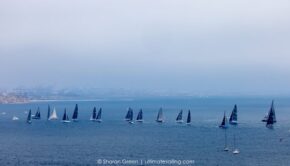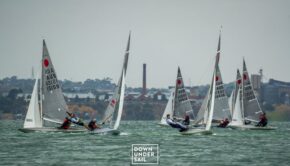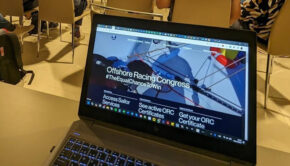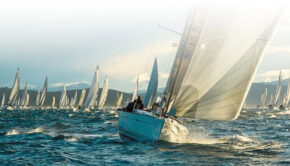HANDICAPPING: A history of failure. A solution to consider.
Published on June 20th, 2013
By Tim Dick
I like to race sailboats, but I’m not a “one design” kind of guy (where absolutely identical boats with identical sails & identical crew weights race together) because I don’t get to use any ingenuity, creativity or technology. The problem is, outside one-design racing, yacht racing has failed.
“Development-class” yacht racing holds great conceptual appeal for owners who want to tweak their own boats, yet these formerly large race boat populations have collapsed due to increasingly-rapid failure of rating rules. (i.e. handicap systems where similar but non-identical boats race together.)
Over the past 80 years, each rule has lasted half as long as its predecessor – usually due to slow and / or dangerous boats, unmanageable costs and sometimes boats that are hopelessly uncompetitive even before they hit the water.
Inception: Rule: Duration
1930: CCA/RORC: 40 years
1970: IOR: 20 years
1990: IMS (VPP): 10 years
2000: IRC/ORC (VPP): 5 years
HPR: ??
As a result, development-class boat numbers have collapsed worldwide from Cowes Week to the Giraglia Cup or Key West Race Week, while there is a boom in One Design fleets. (Key West now offers only one-design and PHRF)
What happened here? (Moore’s Law backwards.)
This disaster is is the opposite of Moore’s Law of semiconductors where electronics performance doubles approximately every 18 months creating huge new markets, so the result should be no surprise.
The CCA and RORC racing rules were established in the 1930s and produced excellent racing & great boats through the 1960s. However it failed to evolve to new high-performance materials such as fiberglass hulls, aluminum masts and dacron sails. (40 years.)
The International Offshore Rule (IOR) was therefore introduced in 1970 and produced heavy and slow boats (how fun is that?) until Sparkman & Stephens figured out how to game the rule leading to “dangerously unmanageable boats” (S&S own words) downwind due to the exaggerated mid-boat beam and pinched-in sterns the rule favored. IOR was modified numerous times resulting in boats becoming worthless in one year giving IOR its infamous nickname: ”Invest Or Retire.” IOR was all but dead by 1990. (20 years)
Meanwhile the Wizard of Santa Cruz (Bill Lee) and others were building planing “ultralights” like Merlin in the late 1970s and obliterating distance records like the Transpac by days. As Bill Lee famously said, “fast is fun” but this fun would have to wait more than a decade because worldwide racing remained dominated by old-fashioned “leadmine” oriented rules.
IOR was replaced in the mid 1990s by International Measurement System (IMS), the first “black box” computer velocity-prediction program (VPP) rule where a secret (and evolving!) mathematical formula determined your rating. Designers guessed at the optima and this produced some excellent all-around boats until Farr + Beneteau figured out the combination of high-freeboard + light keels were the way to game this design resulting in the popular Beneteau First 40.7 aptly nicknamed the Beachball.
Subsequently designers Botin-Carkeek extended that trend by ballast out of the keel and putting it in the bilge (reducing stability / safety and increasing weight) producing winning but slower and less safe boats. That was the beginning of the end of IMS. (10 years)








 We’ll keep your information safe.
We’ll keep your information safe.